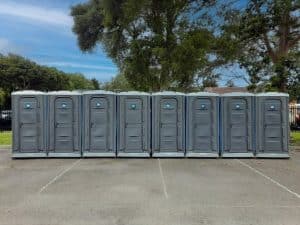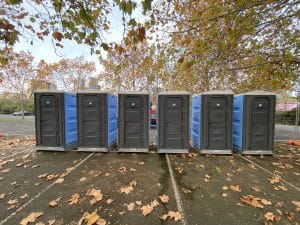You have probably used a few portable toilets in your life, but have you ever stopped to wonder how they work? A portable toilet is a contained toilet cubicle that is not connected to any sewer system, making them the ideal option for events, building sites and more.
If you’re considering hiring a portable toilet for your next construction project, festival or outdoor party, we explain exactly how they work and answer some common questions people have about portaloos.
Components of a Portable Toilet
There are four main parts of all portable toilets: the toilet seat, the flushing mechanism, the holding tank and the pressure system. All of these are vital for the smooth operation of the portable toilet.
Most portable toilets also feature other components to make them more comfortable and hygienic, such as wash basics, non-slip floors, soap and more. But the four key parts are the basics that are required for a functioning portable toilet.
The toilet seat operates like any other toilet seat, including the one in your own home.
The flushing mechanism also works a lot like a regular toilet flush, but in a portable toilet these are commonly operated using a foot pump. This makes it more hygienic and keeps the portable toilet from being a place to spread germs.
The pressure system is what allows water to be delivered into the toilet and to remove waste from the bowl.
Finally, the holding tank works instead of a sewage system. This is where the toilet waste is held and stored until it can be emptied and cleaned.
All of these components work together to make your portable toilet able to operate for long stretches of time without the need for any water or sewerage connection.
How Does a Portable Toilet Work?
All portable toilets use water, toilet chemicals, or a combination of both when flushing.
For water-flushing portable toilets, there is a concealed water tank in the toilet unit. Sometimes this tank also services handwashing taps within the toilet, and sometimes the two are separate water sources.
When you flush, the waste is transported to a holding tank in the portable toilet. The holding tank is the key part of the toilet, allowing it to store waste over a long day on site or at an event. Portable toilet holding tanks are made of sturdy materials but are also very light to make the toilets easy to transport to different locations. They are normally made of durable plastic.
Portable toilets holding tanks contain chemicals which work to control hygiene. This chemical additive breaks down waste, kills bacteria and masks any unpleasant toilet odours – so you don’t end up with a stinky portaloo at the end of the day! The chemicals in the holding tank are also what makes portable toilets hygienic and safe for use.
Common Questions about Portable Toilets
How often do you need to clean and empty portable toilets?
Modern portable toilets, such as the ones used by Ahoy Hire, can be used for long periods of time without the need to be emptied and cleaned. The frequency of this depends on the usage of the toilet. If lots of people are using the portable toilet, such as at a festival, the toilet will need to be cleaned and emptied at the end of the event. If it’s being used by less than three people, such as on a building site, you can wait a month before a clean and empty.
How do I know a portable toilet is clean when I hire it?
Ahoy Hire always deliver portable toilets that have been thoroughly pumped and cleaned. We use the best cleaning products to ensure that your portable toilet is hygienic and pleasant to use.
What if I need my portable toilet cleaned while it’s still in use?
Sometimes you will need a clean and empty before your hire period is up. If this happens, Ahoy Hire offer emergency on-site pump and clean services. This can be pre-arranged, or we are also available for emergency call-outs if needed.
Advantages of Using Portable Toilets
Portable toilets offer a convenient and clean option for any location where access to regular plumbing isn’t available. They can be quickly and easily installed on site and can be placed anywhere with enough space.
Tips for Hiring Portable Toilets
When hiring portable toilets, there are some key things to consider:
- The number of people who will be using them. Make sure you have enough to cater for the crowd and think about how often they may be used (for example, at an event where alcohol is served, toilets are often used more frequently).
- Where the toilets will be placed. Portable toilets are not anchored to the ground, so they need to be placed somewhere flat and stable. Additionally, there are rules around the placement of portable toilets on construction sites that builders should be aware of.
- How often the toilets will require cleaning. Factor cleaning and pumping into your considerations and make sure you have enough toilets so that if one is being serviced, you still have facilities available.
Contact Us Today
Get in touch with us today:
- Get a quote
- Call us: 0413 477 360
- Email us: [email protected]



